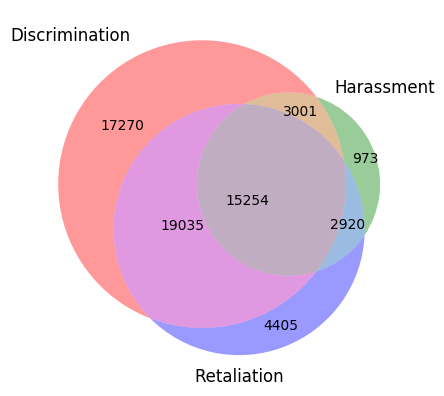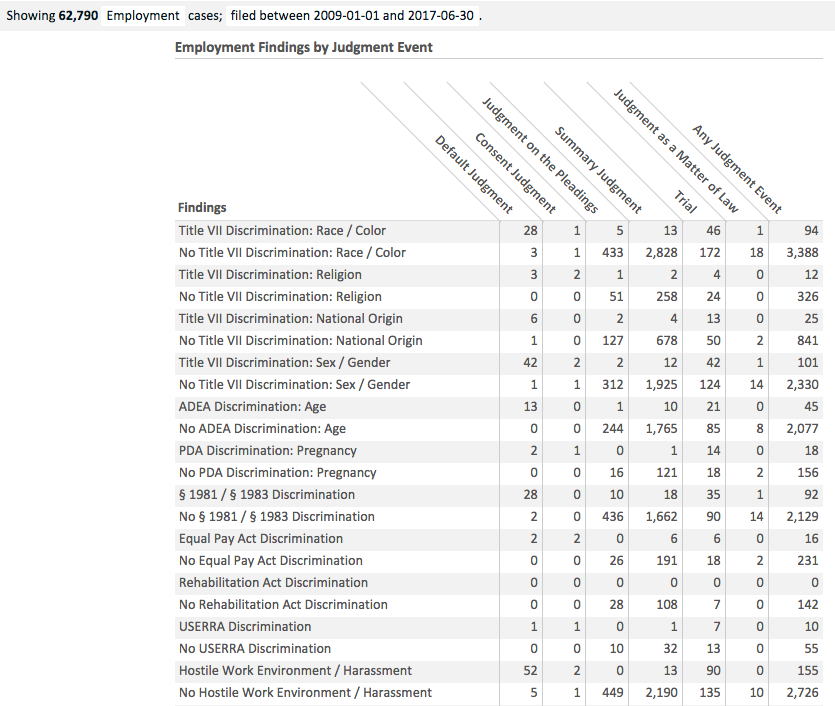As the next step in bringing Legal Analytics to more areas of the law, Lex Machina has expanded our coverage of employment cases pending January 1, 2009 through the present. Our employment module offers the same ease-of-use and intuitiveness as our other practice areas, but introduces new tags, findings, remedies and damages specific to employment law.
Discrimination, Retaliation, Harassment
Lex Machina tags employment cases by the nature of the claims asserted, resulting in three (overlapping) categories: discrimination, retaliation, and harassment/ hostile work environment.
- Discrimination cases involve claims under federal statutes that prohibit adverse employment actions against members of a protected class.
- Harassment cases involve claims of unwelcome conduct based on an employee’s protected status.
- Retaliation / hostile work environment involve claims that an employer punished or retaliated against an employee because the employee engaged in a legally protected activity.
Based on cases filed between January 1, 2009 through June 30, 2017, discrimination lawsuits are by far the most common (87% of cases), followed by retaliation (66%) and harassment (35%). However, employment cases often involve overlapping kinds of claims – discrimination and retaliation claims are combined more than half the time (54%), and the other two combinations occur in about a third of cases. Cases with all three tags comprise just under a quarter of the cases (24%).
Number of cases tagged as Discrimination, Harassment, and/or Retaliation with overlaps (cases filed 2009 through 2017 Q2)
These tags help practitioners focus in on the relevant cases, ensuring that other statistics and insights are more precise that would otherwise be possible.
Top Defendants and Top Defense Firms
While Lex Machina’s upcoming Employment Litigation Report will provide more in-depth coverage of top parties and law firms, this post takes a preliminary look at the defense side (by cases filed 2009 through Q2 2017).
The list of top defendants reflects the entities that tend to employ the most people: government and large corporations. On the government side, that includes municipal organizations like the City of New York and the Metropolitan Washington Airport Authority, as well as federal organizations like the U.S. Post Office and Department of Defense. Top corporations by employment cases include companies with a nationwide presence like Wal-mart, Home Depot, Target, United Parcel Service, Bank of America, and United Airlines.
While these entities have the most employment cases, it does not follow that that they engage in the most discriminatory/retaliatory/harassing behavior, or even that they received the most complaints. Typically, employees alleging discrimination, retaliation or harassment have to file a claim with the Equal Employment Opportunity Commission (EEOC) before proceeding to district court. Some entities may be more effective at resolving disputes at the EEOC (or otherwise) before they reach district court, diminishing their ranking by employment cases; conversely others may be less effective at early resolution and therefore have proportionately more employment cases. Finally, the filing of an employment cases should not be substituted for a verdict vindicating the plaintiff.
The top law firms representing defendants include Littler Mendelson, Jackson Lewis, and Ogletree Deakins Nash Smoak & Stewart. Unlike commercial litigation or IP, where many firms represent both plaintiffs and defendants, employment litigation is stratified – firms generally specialize in representing only one side.
Findings and Federal Statutes
Lex Machina classifies findings in employment cases by the various federal statutes the claims are rooted in, including the Civil Rights Act of 1964 (Title VII), Age Discrimination in Employment Act of 1967 (ADEA), Equal Pay Act of 1963 (EPA), Equal Rights Under the Law (42 U.S.C. §§ 1981, 1983), Title II of the Genetic Information Nondiscrimination Act of 2008 (GINA), Pregnancy Discrimination Act (PDA), Immigration Reform and Control Act (IRCA), Rehabilitation Act, and Uniformed Services Employment and Reemployment Rights Act of 1994 (USERRA).
Across the board, findings of no discrimination/retaliation/harassment under these statutes are far more common that findings favoring the plaintiff. The bulk of findings in favor of defendants occur at summary judgment, while plaintiffs go to trial for vindication.
Among the cases reaching a merit-based outcome, the most common statutes include Title VII Discrimination on Race / Color and on Sex / Gender. However, among plaintiffs reaching a merit-based outcome have higher odds of prevailing when the statute involved is the Pregnancy Discrimination Act or the USERRA (The Uniformed Services Employment and Reemployment Rights Act of 1994).
This level of detailed findings, combined with Lex Machina’s other data on parties, law firms, and timing gives practitioners unprecedented insight into the kinds of cases that are filed, how long they take, and how they resolve. This data can turbocharge business development for firms, or help in-house lawyers find the right outside counsel for a particular case. From analyzing the most/least successful defenses to detailed case timing breakdowns, this data is invaluable for any practitioners of employment law.



